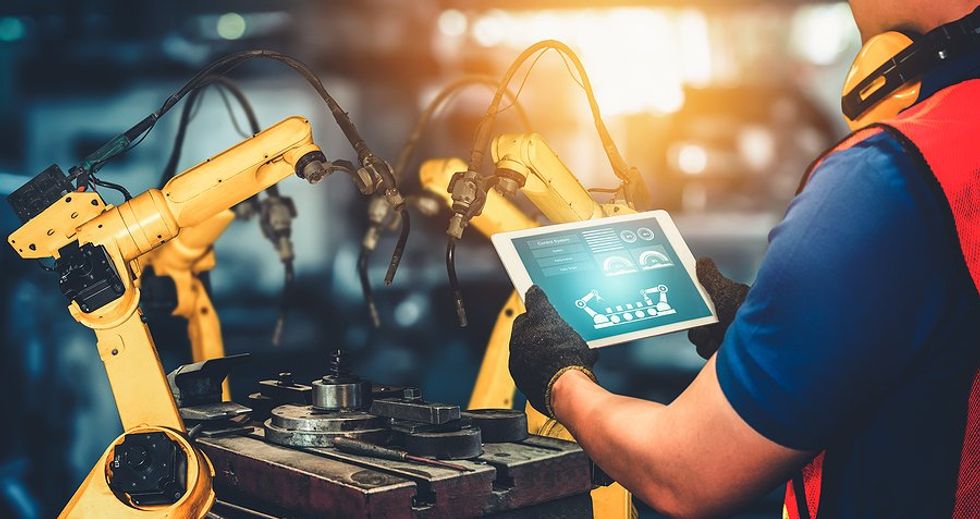
Automation will shape the way we work and thrive in the years to come. The technological landscape is constantly evolving, and keeping up with that evolution is necessary for professionals, executives, and businesses if they want to stay relevant and competitive. So, how will automation transform employment, skills, and job market trends? How will it impact different industries and jobs?
We recently asked our leading executives what they think automation means for the future of work in their respective industries.
Here are their responses...
Lisa Perry, Global Marketing Executive
Automation is already here and impacting businesses every day. As a brand marketer, automation has been a game changer from chatbots to ChatGPT. In 2023, global marketing automation spending will reach $25 billion. At this point, it’s in your best interest to embrace these transformative technologies. Here’s why.
Customer Insights and Personalization:
Automation platforms such as Salesforce Marketing Cloud, Adobe Analytics, Google Analytics, and Tableau enable brand marketers to gather and analyze vast customer data in real time. This wealth of insights into customer behavior, preferences, and trends enables marketers to create highly targeted and personalized messaging, content, offers, and marketing campaigns. By leveraging tools that harness this data, marketers can deliver the right message to the right audience at the right time. This allows for continuous optimization and agility in adapting to changing market dynamics, ultimately driving better results, including increased engagement, conversion rates, ROI, and improved customer experiences.
Streamlined Processes and Efficiency:
Automation can streamline many routine, repetitive, and time-consuming tasks. Marketers can focus their efforts on strategic planning and creative thinking by automating data analysis, content creation, scheduling, responding to inquiries, product recommendations, campaign management, and even chatbot interactions with customers. Automation tools like HubSpot and Marketo allow for greater productivity and the delivery of personalized brand experiences at scale.
Improved Content Creation and Delivery:
Automation helps optimize content creation. Tools like Canva and ChatGPT simplify content creation and distribution for brand marketers. Platforms like Canva provide easy-to-use templates, intelligent image selection, and automated scheduling capabilities. Platforms like ChatGPT use cutting-edge AI technology to produce high-quality content at scale, saving time and resources. A study by Gartner predicts that by 2024, AI-generated content will account for 30% of the total content produced by enterprises. Automation streamlines content creation processes, increases productivity, and allows agile responses to market trends and consumer demands.
Human-Centric Creativity:
Marketers can harness the power of automation to streamline repetitive tasks and dedicate more time to creative thinking and ideation. Tools such as Adobe Creative Cloud and Hootsuite offer a wealth of inspiration, creative resources, and collaboration features that ignite innovation. Marketers can craft unique and emotionally impactful brand experiences by combining creativity with automation-driven insights.
Automation has the power to revolutionize the future of work for brand marketers. It’s important to ensure that automation enhances rather than replaces human creativity and empathy, creating an impactful and authentic brand experience.
Lisa Perry helps companies build leadership brands, driving loyal customers & delivering profitability. She does this through a process that builds brands consumers love. Her goal is to help companies develop, monetize, and grow their brands.
Lynn Holland, VP Sales & Business Development

Image from Bigstock
As a tech seller, I have found in recent years that traditional corporate decision-makers have been fairly slow to understand, cost justify, or embrace digital transformation even when presented with a clear business case. This has limited automation’s threat to the human workforce.
However, as decision-making has started falling to younger executives facing greater pressures to increase productivity and profitability in an app-for-everything world, NOT investing to automate low-value activities when there is a fairly rapid payback has become increasingly difficult to refuse and justify.
Fast forward to 2023 as artificial intelligence and machine learning models are coming out of the shadows of expensive, engineer-intensive, heavy applications into readily available, open-source everyday tech. I believe automation represents both an opportunity and a challenge for the modern workforce, determined through a worker’s initiative to stay relevant by learning about and embracing new technology in their industry and role.
A few measures will help workers proactively position themselves to coexist with technology in the workplace:
- Acknowledge that low-value, repetitive tasks and jobs will be eliminated.
- Seek out opportunities to be an early user of new technology in your organization.
- Reduce personal expenses to withstand a job transition if needed and enable proactive investment into ongoing education.
- Become a perpetual learner. Commit to learning about emerging technology applicable to your industry and your role. Invest also in upskilling essential human skills like communication, building influence, problem-solving, creativity, critical thinking, and emotional intelligence.
Whether learning from trusted content on YouTube, a masterclass, a paid course with a community of peers, a respected business book, or college coursework, make learning and personal development a priority.
- Think like an entrepreneur by looking for unmet needs around you to innovate a product, service, or even a new app to solve the problem. With many tech tools and open APIs available with low/no code, it is a great time to start a business or side gig to create a new revenue source.
- Join a community of peers to be challenged and supported in your personal development.
- Prioritize building your personal brand with a content strategy and perpetual content distribution to gain visibility, improve your image, document and share your expertise, and expand your network and opportunities.
Lynn Holland is a business development executive with 18+ years of experience taking operational, IoT & retail technologies, products, & consumer engagement to market with a focus in petroleum & convenience retail.
Michael Willis, Sports Business Operations Executive

Image from Bigstock
Workplace automation uses systems to perform predictable and repetitive tasks without human input.
Does this mean people will lose their jobs? Will automation further shrink the workforce?
I use automation all the time at the NFL in working in finance operations. I create macros in my Excel spreadsheets to grab data in one cell to use it in another cell to tell a story. I further use macros in budgeting and forecast modeling.
On the football field, automation monitors the game for many purposes:
- The broadcast center uses various camera feeds to call the game with play-by-play precision. Sports journalism is big business when it comes to covering statistics and data.
- The on-field game officials and replay officials use camera shots that show various angles so that the coaches can challenge the split decisions made by the game officials. Cameras are placed in the end zones to cover precision views for scoring. Every game is highly competitive, and every call can make a difference between winning and losing.
- Game officials on the field are graded using automation systems to track the calls they make on the field. Good calls, bad calls, no calls. This grading is employed to place officials in postseason games.
- The coaching staff uses sideline tablets on the sidelines to review the playbook for upcoming plays and formations.
- Scouting and recruitment uses automation to get play-by-play stats and activity on every player. Tracking injuries. Time off the field. Player performances. Health and safety reporting.
Michael Willis has 18+ years of experience working with accounting & sports organizations and has managed P&Ls of $10M - $125M+ with budgets of $3M-$50M+. He worked for the NFL for 22 1/2 years, mainly with the game officials working on the financial/accounting side of the business.
Ana Smith, Leadership Development & Learning Strategist

Image from Bigstock
In an era defined by technological advancements, automation has emerged as a transformative force shaping the landscape of work. As industries embrace intelligent machines and algorithms, the future of work is undergoing a profound revolution. I would like to delve into some key pros and cons of automation to navigate this transformative shift.
Some key pros of automation:
- Increased Efficiency: Automation eliminates repetitive and mundane tasks, allowing workers to focus on higher-value, creative, and strategic work. This leads to increased productivity and efficiency in various industries.
- Enhanced Safety: Robots and machines can perform dangerous or hazardous tasks, reducing the risk of workplace accidents and injuries. This is particularly beneficial in industries such as manufacturing, mining, and construction.
- Cost Savings: Automation can lead to significant cost savings for businesses, as machines do not require wages, benefits, or breaks. It streamlines operations, reduces errors, and optimizes resource allocation.
- Improved Quality: Automated systems can consistently produce high-quality outputs, minimizing errors and variations. This is particularly valuable in sectors such as healthcare, where precision and accuracy are critical.
- Job Creation: Contrary to popular belief, automation has the potential to create new jobs which do not exist today. As technology advances, new roles emerge that require skills in programming, robotics, data analysis, and maintenance of automated systems.
Some key cons of automation:
- Job Displacement: The rapid adoption of automation technologies can lead to job displacement for workers performing routine and repetitive tasks. Certain occupations may become obsolete, requiring individuals to reskill or upskill to remain relevant in the workforce.
- Income Inequality: The benefits of automation are not evenly distributed, potentially exacerbating income inequality. Workers who are displaced may struggle to find alternative employment, leading to socioeconomic disparities.
- Lack of Human Interaction: In industries where automation is prevalent, such as customer service or hospitality, the absence of human interaction can impact the quality of service and customer satisfaction.
- Ethical Considerations: Automation raises ethical concerns regarding privacy, data security, and algorithmic bias. Striking the right balance between technological advancements and ethical guidelines is crucial to ensure responsible automation.
The question for each one of us is how are we preparing for it.
Ana Smith helps people & organizations achieve their full talent potential by developing and co-creating people strategies and customized solutions, and turning them into impactful outcomes and collaborative relationships, using coaching as the "red thread.
What do you think automation means for the future of work? Join the conversation inside Work It Daily's Executive Program.
- Career Advice For Surviving Automation In The Workplace ›
- CEO Critical Conversations: How Communication Failures Cost Your Company Millions ›
- Driving Revenue vs. Optimizing Profitability: How To Work Smarter For Business Growth ›
- 10 Ways Employees Can Be More Proactive At Work ›
- The Benefits Of Managing Content With Document Imaging - Work It Daily ›
- How Artificial Intelligence (AI) Will Transform Management - Work It Daily ›
- The Impact Of Email, SMS & Marketing Automation Strategies - Work It Daily ›
- Future Of Work: How Will AI Impact Workplaces? - Work It Daily ›
- 9 SaaS Hospitality Apps To Streamline Business Operations - Work It Daily ›
- What AI Means For The Future Of Work - Work It Daily ›

 Bigstock
Bigstock Bigstock
Bigstock Bigstock
Bigstock


